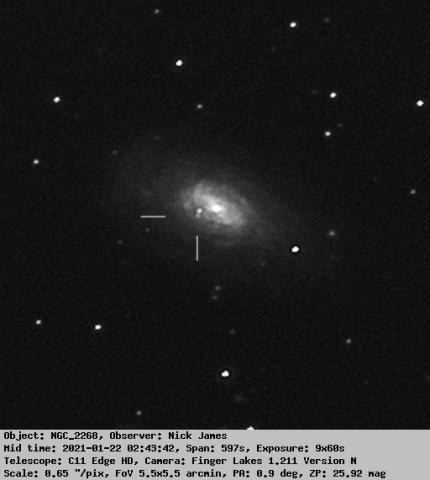- This topic has 12 replies, 3 voices, and was last updated 4 years, 11 months ago by
 Nick James.
Nick James.
-
AuthorPosts
-
12 January 2021 at 3:18 pm #574862
 Robin LeadbeaterParticipant
Robin LeadbeaterParticipanthttps://www.wis-tns.org/object/2021aai
mag 18.7 at discovery but could reach mag 13 (plus extinction) if type Ia
Robin
—12 January 2021 at 10:21 pm #583685 Nick JamesParticipant
Nick JamesParticipantHere’s an image of it from Jan 12.9. It is a difficult object to measure since there is a 17th mag star around 3 arcsec north of it. I get 17.9 tonight.
13 January 2021 at 12:34 am #583686 Robin LeadbeaterParticipant
Robin LeadbeaterParticipantWell done for splitting it from the nearby star. I put the spectrograph slit on it but it is so messy round there, it is going to have to outshine the star and galaxy background if I am going to have any chance.
13 January 2021 at 5:49 pm #583692 Nick JamesParticipant
Nick JamesParticipantYes, I thought this one would be a challenge. It had a whole galaxy to go off in and it did it next to a relatively bright field star! How big is the slit you use and can you orient it to avoid that star?
13 January 2021 at 11:47 pm #583705 Robin LeadbeaterParticipant
Robin LeadbeaterParticipantThe slit is 23 microns or 3 arcsec. It normally runs in the Dec direction which is probably the best bet as the star and PSN will lie at different positions along the slit provided the seeing and guiding is good enough to split them. I could just pick up a weak spectrum of the pair with perhaps signs of a broad H alpha emission line which would indicate a type II, though there is quit a bit of that around in the galaxy background as well. No split though (and to be honest at mag 17.9 I would not stand much of a chance of getting a useable spectrum in any case)
16 January 2021 at 1:21 pm #583724 Robin LeadbeaterParticipant
Robin LeadbeaterParticipantIt looks like it has levelled out, well (~5 mag) short of what a type Ia without extinction would reach
16 January 2021 at 6:10 pm #583725 David SwanParticipant
David SwanParticipantDo you have any guesses / good ideas about what it might be, Robin?
16 January 2021 at 11:12 pm #583726 David SwanParticipant
David SwanParticipantI captured the transient this evening (2021/01/16 20:30) – it is still dimmer than the nearby field star.
17 January 2021 at 12:22 pm #583727 Robin LeadbeaterParticipant
Robin LeadbeaterParticipantWell the distance to NGC2268 is probably reasonably accurate as it based on Ia supernova 1982B (which was V mag 13.5 when discovered just past maximum) so assuming this object is say mag 17.5 at maximum this gives it an absolute magnitude of -14.8 There is then 0.2 mag extinction from our own galaxy giving abs mag v mag ~ -15 which is very much at the low end but not unknown for supernovae eg
https://arxiv.org/abs/astro-ph/0112051
but if there is a lot of extinction in the host galaxy it could be higher luminosity of course.
(It could also be a foreground CV of course. We need a spectrum)
It is interesting that there has been no published professional classification yet. Maybe it is something interesting and the classification is being withheld. (Not unknown. Classifications can be submitted to TNS with an embargo)
Cheers
Robin
17 January 2021 at 1:10 pm #583728 David SwanParticipant
David SwanParticipantThanks Robin.
On the topic of atypical phenomena, others may be interested that there is a nice article on transients, written by Anna Ho, in the December 2020 issue of Scientific American. Amongst other things, she talks about SN2018gep and the famous ‘cow’, which spawned many strange illustrations of floating cows, AT2018cow.
18 January 2021 at 7:13 pm #583731 Robin LeadbeaterParticipant
Robin LeadbeaterParticipantZTF have now called it on TNS as a type II based on a spectrum they took 5 days ago. I would not say their spectrum is over convincing though (A hint of a broad H alpha emission at the galaxy redshift, perhaps with a P Cygni profile but not much else) and running it through SNID does not come up with any high confidence hits. It shows a blue continuum suggesting not much IS extinction so it seems to be very much at the low luminosity end
Cheers
Robin
18 January 2021 at 8:38 pm #583732 Robin LeadbeaterParticipant
Robin LeadbeaterParticipanthttp://www.astronomerstelegram.org/?read=14326
with what sounds like a better spectrum, confirms likely IIP with low luminosity (-14.5)
23 January 2021 at 5:06 pm #583739 Nick JamesParticipant
Nick JamesParticipantHere it is again from Friday morning. The variable is still around mag 18 so not doing a lot.

-
AuthorPosts
- You must be logged in to reply to this topic.
